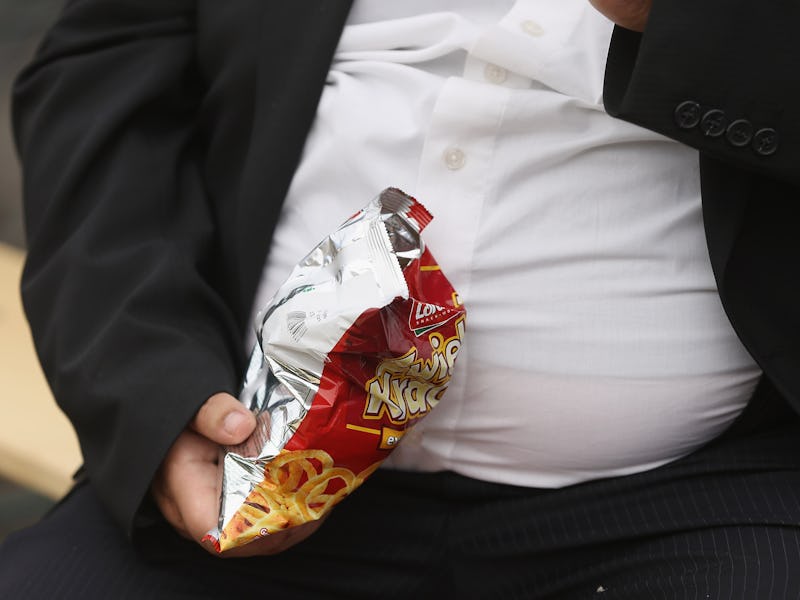There's a Chemical Reason Heavier People Have Trouble Losing Weight
When inflammation interacts with fat, your fat stores become more permanent.

Losing weight can be really difficult for some people, and the more you weigh, the harder it may be. Sure, we can blame our inertia on a lack of motivation to hit the gym or a busy work schedule. Perhaps we blame the difficulty on our genes. But the simple truth is that, for whatever reason, losing weight is not easy, especially when you’re really big. Now, scientists have identified a molecular factor that explains why it might be so frustrating and challenging to shed those extra pounds.
In a paper published in the January 2018 issue of the journal Metabolism, a team of European researchers argued that obese people experience a phenomenon in which their adipose tissue — aka fat — gets inflamed and becomes scarred. The result of this scarring is that fat becomes a more permanent fixture in the body.
Obese people have more problems than simply body mass. Their fat can make it harder to lose weight.
“Scarring of fat tissue may make weight loss more difficult,” study coauthor Katarina Kos, a senior lecturer specializing in type 2 diabetes and obesity at the University of Exeter in the UK, said in a statement.
This scarring occurs, say the study’s authors, because as a person’s mass and volume of body fat increase, the fat cells struggle to receive enough oxygen, leading to inflammation of the fat cells. Inflammation and oxygen starvation, in turn, are associated with increased levels of a protein called lysyl oxidase, which aids in crosslinking collagen fibers. When too much lysyl oxidase is produced, too many of these fibers get crosslinked, and the fat tissue exhibits fibrosis — the medical term for scarring of an organ.
There's a molecular reason obese people have trouble shedding weight.
The study’s authors conducted this research by collecting tissue samples from (willing) participants undergoing bariatric surgery as well as less-heavy subjects to compare. By measuring the expression of lysyl oxidase in the samples and comparing it to these people’s body mass index (a measure of obesity), they found that the obese subjects had much higher levels of the protein. They also found that levels of lysyl oxidase correlated positively with BMI. Subjects undergoing bariatric surgery typically have had trouble losing weight with diet and exercise, and this research offers a possible explanation as to why weight loss is so difficult for people with high BMIs.
“But this does not mean that scarring makes weight loss impossible,” said Kos. “Adding some regular activity to a somewhat reduced energy intake for a longer period makes weight loss possible and helps the fat tissue not to become further overworked. We know that doing this improves our blood sugar and is key in the management of diabetes.”
So for obese people who choose to slim down — and not all people who are big want to be smaller — fat scarring creates an additional hurdle, but by no means is it insurmountable.
Abstract:
Background/objectives: Lysyl oxidase (LOX) is an enzyme crucial for collagen fibre crosslinking and thus for fibrosis development. Fibrosis is characterised by a surplus of collagen fibre accumulation and is amongst others also a feature of obesity-associated dysfunctional adipose tissue (AT) which has been linked with type 2 diabetes. We hypothesised that in type 2 diabetes and obesity LOX expression and activity will be increased as a consequence of worsening AT dysfunction. This study aimed to provide a comprehensive characterisation of LOX in human AT.
Methods: LOX mRNA expression was analysed in omental and abdominal subcutaneous AT obtained during elective surgery from subjects with a wide range of BMI, with and without diabetes. In addition, LOX expression was studied in subcutaneous AT before and 9.5 months after bariatric surgery. To study the mechanism of LOX changes, its expression and activity were assessed after either hypoxia, recombinant human leptin or glucose treatment of AT explants. In addition, LOX response to acute inflammation was tested after stimulation by a single injection of lipopolysaccharide versus saline solution (control) in healthy men, in vivo. Quantity of mRNA was measured by RT-qPCR.
Results: LOX expression was higher in obesity and correlated with BMI whilst, in vitro, leptin at high concentrations, as a potential feedback mechanism, suppressed its expression. Neither diabetes status, nor hyperglycaemia affected LOX. Hypoxia and lipopolysaccharide-induced acute inflammation increased LOX AT expression, latter was independent of macrophage infiltration.
Conclusions: Whilst LOX may not be affected by obesity-associated complications such as diabetes, our results confirm that LOX is increased by hypoxia and inflammation as underlying mechanism for its upregulation in adipose tissue with obesity.